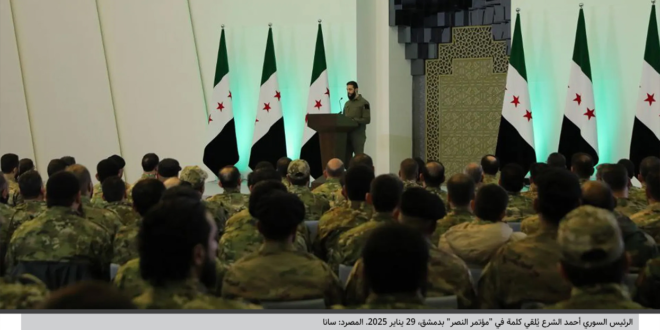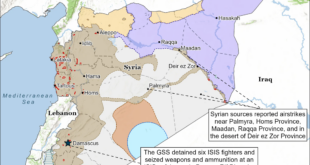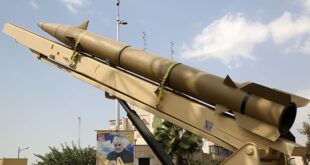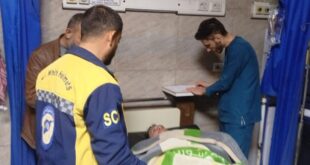The process of rebuilding the Syrian army after the change of the Assad regime faces structural and political challenges to the formation of an inclusive national military institution, where the current Syrian military scene suffers from sharp divisions, in addition to concerns about the ideological identity of the emerging army, its impact on internal cohesion and the international situation, as well as the limited representation of the various Syrian components within its structure. Therefore, the success of the reconstruction of the Syrian army depends on its ability to represent the diverse Syrian society and the existence of international support conditional on accountability and transparency.
The reconstruction of the Syrian army after the Assad regime change in December 2024 is a very complex and pivotal task for long-term stability in the country. It is not only a military matter, but is intrinsically linked to the broader project of nation-building and the formulation of a new social contract. This process is also affected by several factors, most notably national reconciliation and the balancing of regional interests and concerns. The success or faltering of this experience is expected to have significant implications for the stability and security of the Middle East in general. Key challenges include addressing and effectively integrating internal divisions between factions, establishing robust mechanisms for scrutiny and accountability, dealing with the issue of foreign fighters, and reactivating the system of mandatory recruitment in a transparent manner. Challenges also include overcoming logistical and financial constraints, securing multilateral international support, and defining a clearly defined national military doctrine. Accordingly, this paper aims to provide a comprehensive analysis of the facts, potentials and challenges associated with this process, focusing on the current fragmented status of the military, possible models of restructuring it, and the expected obstacles.
The Current Syrian Military Landscape
The rapid collapse of the former Syrian regime in December 2024, following a military attack led by the armed factions, led by Hay’at Tahrir al-Sham, was a dramatic turning point in the Syrian scene, as the country entered a new phase fraught with uncertainty and complex challenges, especially with regard to the future of the armed forces. The Syrian army, which was the backbone of the regime, was dissolved after a decade of engaging in an internal conflict that severely affected its capabilities; its strength was reduced to less than half as a result of human losses, desertion, and moral decline, leading to its complete collapse with the fall of the regime, and then the announcement of its official dissolution after the transfer of power, which left a large vacuum in the structure of power and led to a turbulent security situation.
This coincided with Israel’s conduct of an air military operation called Saham Bashan, which on December 12 resulted in more than 352 airstrikes in 13 Syrian governorates, destroying more than 80 percent of Syria’s strategic arsenal, including air defenses, radar systems, and naval assets. In parallel with these strikes, Israeli forces took control of the Syrian buffer zone and prominent strategic sites, the most important of which is Mount Hermon, announcing the collapse of the 1974 agreement on the separation of forces signed with Syria.
In the meantime, Hay’at Tahrir al-Sham emerged as a key actor in the political and security scene, forming the pillars of the transitional administration and then the interim government. Ahmed al-Shara’a, formerly known as Abu Mohammed al-Julani, took over the leadership of the transition, before declaring himself president on January 29, 2025. Although he has stated on more than one occasion his intention to build a national army that reflects the ethnic and religious diversity in Syrian society, the subsequent practical steps have not gone in this direction, as it has become clear that the new army consists of almost one component. Former leaders of the Commission dominated ministries and military and defence bodies. Marhaf Abu Qusra, formerly known as Abu al-Hasan al-Hamawi, was appointed defense minister, while Ali Nour al-Din al-Naasan, a former chief of staff, took over as chief of staff. On the other hand, the majority of military promotions and appointments in the ranks of the new army were concentrated among other leaders of the Commission, such as Muhammad Khair Hassan Shuaib (formerly known as ‘Abu al-Khair Taftanaz’) and Abdu Muhammad Sarhan (formerly known as ‘Abu Asim Ghouta’), who was the emir of the ‘al-Nusra Front’ in Eastern Ghouta.
Moreover, a number of foreign fighters in the Commission have been granted quotas for military positions, most notably: Abdul Rahman Hussein al-Khatib (known as “Abu Hussein al-Jordan”), Abdul Aziz Daoud Khadabardi (known as “Abu Muhammad Turkistan”) and Omar Muhammad Jafchi (known as “Mukhtar al-Turki”). This unilateral approach, particularly in the security and military architecture, has raised growing concerns that loyalty will be given priority over recruitment efficiency, raising serious questions about the national character of the new army. Regional and international parties have also expressed concern about the appointment of a number of foreign fighters to leadership positions within the Syrian army, given the repercussions that this may have on the security of neighboring countries, especially since some of these individuals have an extremist past and previous affiliations with international terrorist organizations. These developments come amid a highly fragmented security reality, shaped by multi-loyal armed factions and ideologies, complicating the scene and making it a very difficult challenge to build a national army
Challenges to the Syrian leadership’s approach to building the army
The approach taken by the Syrian leadership in establishing and building the new Syrian army is based on the strategy of “top-down integration.” Initially, the Ministry of Defense was formed with a central command structure, and then it was officially announced that the existing armed factions, led by Hay’at Tahrir al-Sham, had been dissolved and merged under the ministry’s responsibility. However, this approach faces several challenges that may hinder the establishment of a national institution and an effective centralized leadership structure, particularly with two main factors:
First, the extent to which the ministry is able to dissolve internal divisions between the different factions under its umbrella; and second, the impact of this model of integration on the confidence of some components of Syrian society, such as the Kurds, the Druze and the Alawites, along with other components that have so far preferred to take a negative position on political and security participation, such as Christians and Ismailis.
For the first factor, integrating factions into the new army is a multifaceted challenge. These fighters come from different backgrounds, have different motives to fight, and many have participated in different phases of the complex Syrian conflict and the brutal abuses that have permeated it. This raises questions about the extent to which the new leadership is committed to establishing rigorous and effective audit mechanisms, capable of screening and excluding individuals involved in war crimes or human rights violations, both in the past and in the present.
Another equally important question arises as to whether these factions are willing to adhere to the structure of the new army and the decisions of the Ministry of Defense, or whether they seek to maintain their partial independence within the framework of a formal integration. This issue is surrounded by considerable doubts, especially in the light of current experience; despite repeated public statements about the unification of forces under a unified national umbrella, strong evidence suggests that there is a real gap between official discourse and actual reality on the ground, revealing a structural imbalance that hinders efforts to resolve and integrate.
This contradiction is manifested in several manifestations. For example, the Turkish-backed Syrian National Army (SNA), whose estimated 29 000 fighters, has agreed to nominally join the Ministry of Defense, but it still resists full integration and retains much of its operational independence. It continues to carry out independent military operations against Kurdish forces, and many of its factions have engaged in unauthorized activities, including looting and human rights violations, especially in Kurdish-majority areas. Some of these factions have also played controversial roles in sectarian violence, especially in coastal areas.
Thus, integration so far remains a theoretical or “symbolic” procedure in light of deeper problems that go beyond the procedural aspects, as a result of a number of factors, most notably:
1- The deep ideological differences and differences between the various armed factions under the umbrella of the Ministry of Defense, and the difference of their loyalties and references, with each faction retaining its own narrative and historical injustice.
2- Merging the factions while maintaining their organizational entities and structures, as they are; for example, the “Sultan Suleiman Shah Brigade” became the “25th Hama Division”, while the “Hamzat Division” led by Saif Abu Bakr became the “76th Division”. This shows that the new leadership treats the merger as the integration of organizational blocs and not individuals, although the integration and qualification of individuals is more institutionally effective.
3- The factions continue to rely on illegal economies and receive financial and logistical support from external sources, especially the Syrian National Army, which continues to receive direct support from Turkey.
4- The need to rebuild military infrastructure that has been severely damaged by years of war and repeated and intense Israeli strikes. It is a huge logistical and financial task facing the government in a collapsing economy, imposing strict restrictions on efforts to retrofit and modernize the armed forces, and making international aid necessary, albeit potentially a potential source of dependency.
In terms of popular and societal satisfaction, there is a general lack of consensus on the policies adopted by HTS after it took power, especially on the military side. There are great concerns among minority components about the dominant role of the Commission and the possible establishment of an authoritarian regime that does not guarantee the protection of their rights or interests. These concerns have been exacerbated by the clear reliance on the criterion of loyalty in appointments, and the dominance of the Commission in the security and military scene. The integration of individuals with extremist ideologies and previous links with transnational terrorist networks also raises questions about the identity of the new army and the possibility of its transformation into a purely ideological army.
The weak integration and diversity of minorities into the structure of the Syrian army has been a major weakness. However, this situation cannot be separated from the broader structural contexts, either in terms of the sectarian legacy within the former army, and the socialist economic system that has governed Syria for decades. These contexts have been reflected in the nature of Syrian society, as Sunni, Kurdish and Christian sects are known to be reluctant to serve voluntarily in the army, while the former regime imposed on the Alawite component two near-mandated options to secure a living: either joining the army or a civil service.
In addition to the above, there is a divergence of views among Syrian actors on the most appropriate model for building the new army. For example, the SDF has proposed a different model, as a condition for its accession, to be considered a semi-autonomous entity, which retains its own structures under the supervision of the central government, similar to the experience of the Peshmerga forces in Iraq. However, this proposal was strongly rejected by the interim Government.
In fact, the two previous problems—poor inclusion and poor societal representation—are directly related to the influence of external actors. Turkey, for its part, is seeking to establish military bases in Syria without colliding with Israel, exerting constant pressure on the SDF without provoking the United States, while at the same time pushing to integrate the Syrian National Army into the new structure while maintaining its relative independence to serve its interests.
Russia, on the other hand, still maintains an active military presence and is seeking to extend it, especially in coastal areas, further complicating the security landscape. Israel also continues to carry out heavy military strikes and pursues a policy of threatening border geography, but not to plunge the region into complete chaos. This trend is reflected in its preference for a weak, demilitarized Syrian state.
From an ideological army to an ideological army.
The former Syrian army was closely associated with the ideology of the Ba’ath Party, which formed the pillar of the Assads’ rule. The role of the army has not only been to defend the borders of the state and its sovereignty from external threats, but also to be a political and ideological tool that ensures the preservation and survival of the former order. Currently, there are fears of a similar model, but with the difference in replacing the army’s doctrine from a partisan political ideology to a “sectarian” one based on HTS and its ideology, especially in terms of fears that it will not abandon “jihadist Salafism,” especially in light of the influence gained by foreign fighters in the new army, along with the statements of officials in the interim government, the constitutional declaration on March 13, 2025, and the launch of Islamic law as the basis for governance, thus directing the path of establishing the new army.
In fact, following this model and consolidating the ideological character of the new army has local, regional and international repercussions. On the one hand, this model raises doubts about the ability of army commanders to control personnel in the military, and affects the stability of the military. As a result of this situation, the massacres took place on the Syrian coast from March 6 to 10, 2025, and each faction blamed and held other parties responsible, not to mention the weak coordination and communication between the newly formed teams and brigades. It also denies national justifications for the exclusion of foreign fighters, especially from leadership positions. What is reflected in this is the reinforcement of the fears of other Syrian components, and pushes them to further refrain from participating in it, especially from the people of the Sunni component, the majority of which do not agree with those ideologies. It even closes the door to millions of Syrian refugees who are expected to return to the country, who grew up in liberal countries, and some of whom prefer to repeat Western models in Syria.
The ideological nature of the Syrian army, if it is established and clear, will also have repercussions towards the neighboring countries of Syria, although these repercussions come differently in the calculations of those countries. On the one hand, all Arab countries want to reach a moderate Syria, similar to the rest of the countries, and not to appear as a model that may enhance political rivalries and polarizations, or return the region to competing alliances among themselves. It is true that the Arab countries rushed to rapprochement with the emerging authority in Damascus from the first moments of regime change, after the former regime’s space for Iran to strengthen its influence in the country, and the resulting multiple and hybrid threats to the Arab countries, but they also do not want another model in which influence is replaced from Shiite political Islam to Sunni. The region has already tried the disadvantages of this, whether in the rise of Islamists after the so-called “Arab Spring” in several countries, or the growth of terrorist organizations and the control of ISIS over large areas of Iraq and Syria until 2018. Thus, this concern of the Arab countries should be taken into account in the process of establishing the new army, otherwise those countries may move away from sharing their military experiences with the new army, or contributing to the establishment of its structure and doctrine, which require extensive experience that the current authority may not have in Syria.
In addition, there is a clear Israeli position of refusing to share its borders with an ideologically oriented force. Immediately after the regime change, Israel rushed to expand the buffer zone and try to establish a safe depth in southern Syria by approaching a number of sheikhs of the Druze component, under the pretext of providing them with protection. This strategy carries an inherent risk of fostering long-term instability and creating a power vacuum that could be exploited by other actors in the region. Although the Israeli discourse towards the PA in Damascus has changed somewhat, the ongoing Israeli military intervention in Syria, despite widespread international condemnation, remains a major and direct challenge to the new administration’s efforts to extend its sovereignty and rebuild the armed forces
At the international level, whose role is crucial in supporting the reconstruction of the Syrian army, especially in light of the need for coordinated international assistance to provide the necessary financial resources, training programs and equipment for the new armed forces. This comes after fulfilling the requirements and requirements of Western countries, foremost of which is that the military structure is commensurate with the military structures of Western countries, albeit relatively, in addition to the availability of mechanisms for accountability and military and civilian control over the army, in order to prevent the misuse or exploitation of aid to destabilize the country and abroad, in addition to the availability of comprehensive training and education programs focused on professionalism, human rights and international humanitarian law necessary to build a modern and effective armed force.
Finally, rebuilding the Syrian army is not only a military mission, but a complex process that includes national reconciliation and balancing regional interests. Although it is an exceptionally complex task, it is a process fraught with many challenges and risks. In fact, the formation of the Syrian army can properly establish a peaceful and successful transitional process if it reflects in its composition the Syrian society in all its components, and play a role in addressing the multiple problems at the level of the relationship between the state and the citizen, and between the multiple components within society, and represent a participatory approach that represents the state and the people together. Otherwise, significant local and regional repercussions could have
 Eurasia Press & News
Eurasia Press & News




